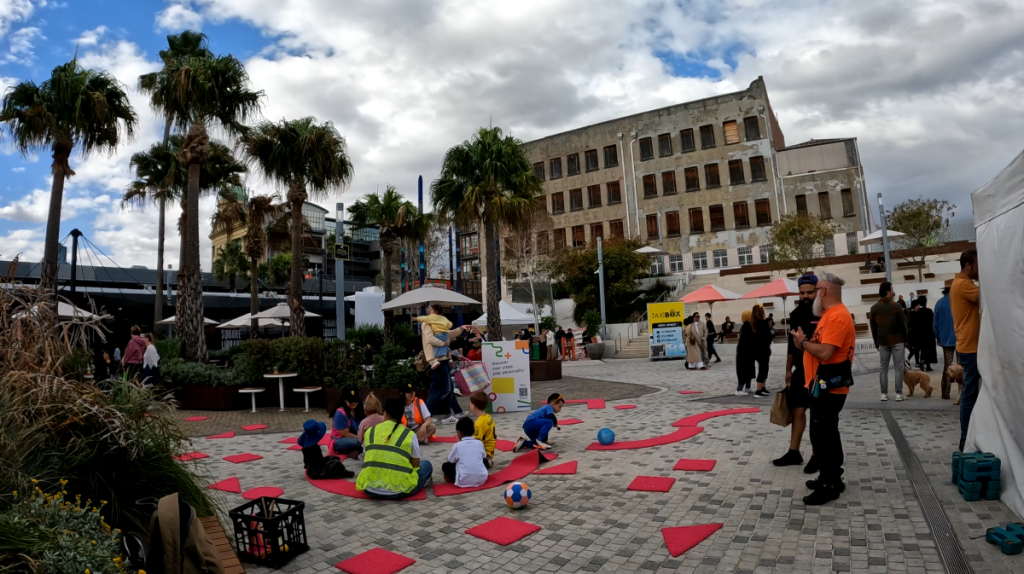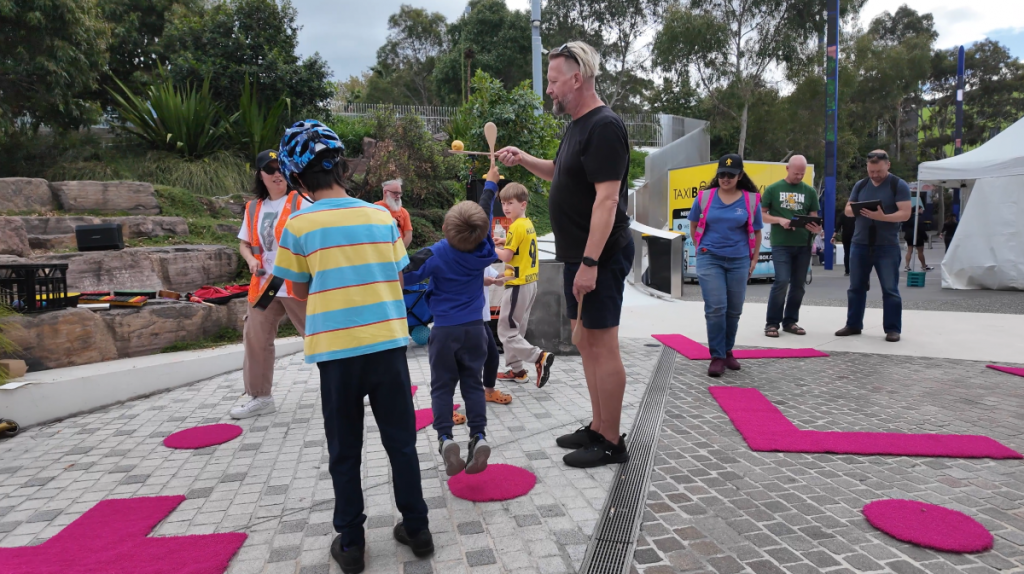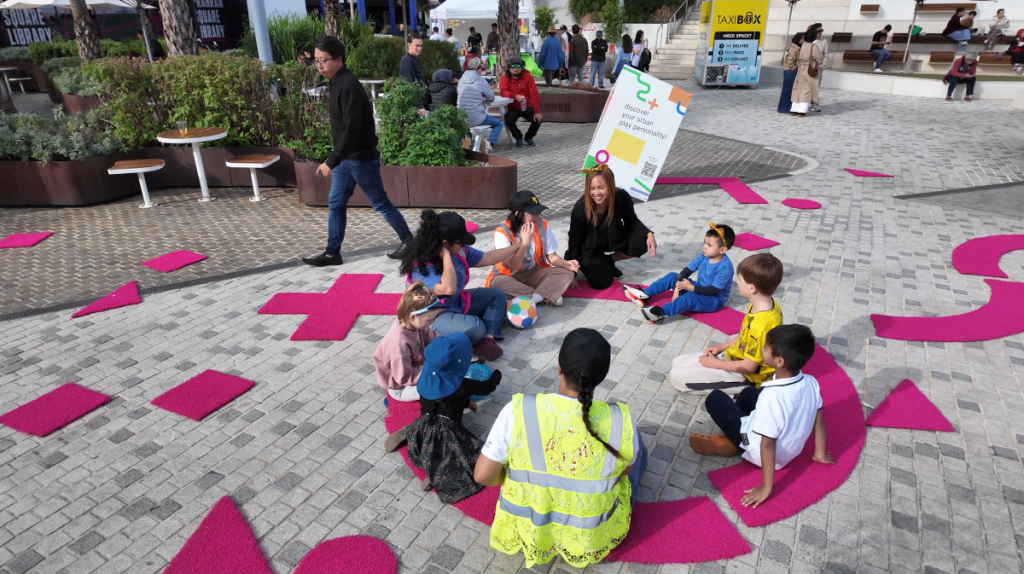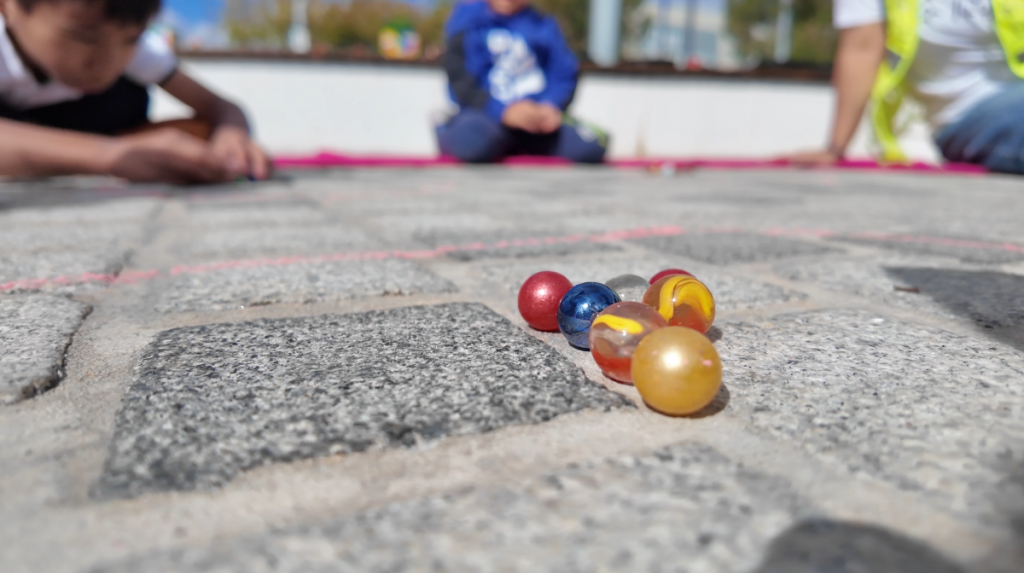A Chance to Test Pop-Up Urban Play
by Aramiha Harwood, Troy Innocent, Carlo Tolentino & Lucy Buxton
On Sunday 6 April, future play lab participated in the Satay and Reog Festival at Prahran Square in Naarm Melbourne. Run by the Indonesian Diaspora Network Victoria, the festival offers a range of cultural performances, food stalls, and fun activities for attendees – with a focus on Indonesian culture, food, and street games. The event fosters community involvement and is attended by many families and children. Activities include traditional dance, fashion shows, parades, music, and various Indonesian food stalls – including satay, of course!

The future play lab were invited by the City of Stonnington to activate some of the space at the Festival through play and games as part of LP220100066 Play about Place. The opportunity to participate meant that the future play lab would have limits on space and time in which to operate, presenting a chance to test the urban play pop-up’s modularity. The team assembled included a Creative Director (Troy), Creative Producer (Carlo), and three Playful Spaces Officers (PSOs).
Carlo devised a ‘medium size’ version of the future play lab’s pop-up play activations based on Troy’s curation and design for St Kilda Festival during brat summer earlier in the year. This medium size pop-up focuses on mobile and agile elements of games and play. This medium version was designed to have games and play equipment that are easily transportable, could be set up relatively quickly, and could be packed up just as fast. Lemon Joust and Sound Square were included in this medium size activation. In addition, an Indonesian student at RMIT helped to implement two other Indonesian games in particular:
One, Two, Three – Wooden Man: a variation of the game Red Light, Green Light, or Statues https://en.wikipedia.org/wiki/Statues_(game)
Semut, Orang, Gajah: a variation of the Rock, Paper, Scissors hand game https://www.mamalisa.com/?t=es&p=5079
Testing of this medium version of the urban play pop-up occurred at the festival, focusing on things such as mobility, modularity, and the use of astroturf shapes to create inherently playful spaces.
On the day, Troy explored different activation sites, observing these for 15-20 minutes, then directing relocation of the activation. The initial location was not ideal due to security concerns and was not encouraging for children and families. Over the day, the Play Activation was moved three times. Each location was used for different durations: the first for 40 minutes, the second for about 1 hour, and the third for nearly 2 hours. Lemon Joust was the most played game on the day. The Indonesian games were well-received by attendees familiar with them, inviting them to play.

Of the three locations, each offered a different context:
- site one: chosen by the event organisers for line of sight with the main stage and audience area
- site two: selected by creative director to be more enclosed and secure, and to intersect with foot traffic from nearby Greville St
- site three: selected by creative director after grabbing a satay snack and observing the busiest area for foot traffic adjacent to food trucks and connecting to nearby Prahran Market. This location also included seating and a set of rock steps ideal for musical instruments and equipment.
There were some difficulties on the day. Sometimes the bands that performed at the festival were very loud, which meant that the Play activation music and discussions involved in engaging play-participants were difficult to hear. The outdoor scope of the Festival meant that the play activations were exposed to heavy wind on the day, and rain meant that the event packed up an hour earlier than expected. It was also felt by some of the Play organisers that the Square itself was not an inviting space – the concrete boundaries of Prahran Square closed off passing foot-traffic who may have been interested in what was going on.

General observations from Play organisers and facilitators noted the overall success of the Play activation at the Satay and Reog festival. Overall Click-counter numbers for the day had 275 people who engaged and/or participated in future play lab activities. Children, parents, and even band members – who were performing on the day – participated in games. When it came time to move the Play to another location at the festival, some parents and children actively helped move equipment between locations – indicating a strong desire to continue playing. Perhaps this relocation activity could be turned into a game itself? Something to think about further…

Familiar Indonesian games significantly encouraged engagement from the Indonesian community, as many attendees recognized them from their childhood.
In terms of mobility of the Play activation, and moving to new locations, it was noted that sight lines are very important for visibility and engagement. The second location had poor sight lines as it was behind a tent and a stage – so it was harder to get an audience to come and play. It is thought that visual cues and open spaces can be important for inviting play, creating a welcoming atmosphere.
Reflecting on the roles of the Playful Spaces Officers (PSOs), it was suggested that providing a clear division of responsibilities could help in engaging more members of the public as potentil play-participants. For example, one PSO could be actively inviting people to play (“hooking them in”) while another could be running the game itself. This could be really useful for PSOs, as it can be hard to maintain attention on one thing, while trying to do another.

It was noted that adults were mostly observers, with some participating alongside their children. This identifies the need to better invite adults to play themselves, not just watch their kids. Opportunities exist to leverage instruments or other engagement tools to encourage active adult participation.
Overall, the Satay and Reog Festival 2025 was an opportunity to try out a medium sized Play activation on site. future play lab organisers have been sufficiently encouraged by this agile and mobile approach to play activations to try this at future events – perhaps making the activations even more ‘pop-up’ in style and approach. Both future play lab organisers and PSO’s were also afforded the opportunity to practice and hone their skills and craft as Play activators – using the opportunity to reflect and build on their knowledge and experience for the future. The future play lab would like to thank the Indonesian Diaspora Network Victoria and the City of Stonnington for this opportunity to be a part of the 2025 Satay and Reog Festival.
Terima kasih!

